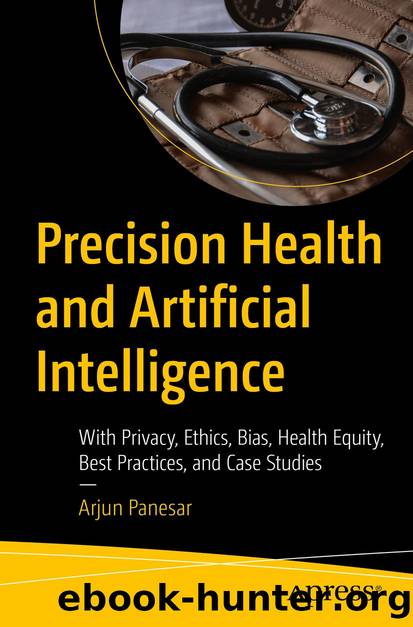Precision Health and Artificial Intelligence by Arjun Panesar

Author:Arjun Panesar
Language: eng
Format: mobi, epub
ISBN: 9781484291627
Publisher: Apress
Published: 2023-01-27T05:35:40.178000+00:00
Figure 5-1 Relationship between interpretability and explainability
Interpretable, explainable AI facilitates patient-centered care by providing clinicians and patients with the necessary information for shared decision-making. Meaningful conversations about the potential benefits and risks of various courses of action can be supported with data and ensure patients receive treatments best suited to their situation, values, and priorities. One could argue that black-box AI is opposed to the tenets of patient-centered medicine. If clinicians cannot fully comprehend the features and calculations that led to a decision, they canât explain how specific outcomes or recommendations were derived.
Reliability and Safety
Precision health systems must perform reliably, accurately, and safely. Bodies such as the FDA in the United States and MHRA in the United Kingdom promote safety and effectiveness by requiring providers to demonstrate these features. When applied to precision health technologies, ensuring outputs are technically reliable in that AI systems have learned correlations from previously seen data and are clinically reliable is paramount.
Ethicists must also balance patient empowerment against risks such as inconsistent oversight of at-home tests, the importance of clinically supervised care, false positive and negative results, incorrectly reported data, and unintended consequences. AI systems augment current care rather than replace it and may sometimes require human intervention.
Imagine an AI system trained to triage obese patients into high and low risk for heart attack. If the system understood from the data that researchers used to train the model that South Asian patients were less likely to die of a heart attack, it might recommend that South Asian patients are at low risk. However accurate this correlation from the data, the conclusion is a misinterpretation that research clinically contradicts. Being of South Asian ethnicity, in reality, increases your risk of heart and circulatory disease, type 2 diabetes, and a variety of co-morbidities.1
Self-improving AI presents another challenge in terms of ensuring reliability and safety. Current regulations assume that products should be clinically tested, manufactured, marketed, and used in a consistent, unchanging form. This is challenging with continuous learning AI, which is constantly changing due to the interpretation and analysis of currently available data. Because of the dynamic nature of continuous learning AI, new methods for ensuring the safety and reliability of such systems will be required. Continuously learning AI requires regulation that provides that ostensible improvements the continuous learning system makes to itself do not instead introduce errors into the model that could cause harm. At the same time, regulation must not require near-constant revalidation of the model.
As has been demonstrated with Caucasian-focused medical textbooks used to deliver healthcare education for generations, the evidence base for most genetic tests is limited and needs more data from diverse populations.2 Diversity and cultural differences play a crucial role in how stakeholders interpret safety in precision health. Until data from under-represented communities is collected at a representative scale, everyone should question it. Clinical tests are helpful only when they provide reliable, actionable information that patients and healthcare professionals can use for clinical decision-making, similar to how behavioral change interventions are beneficial only when they engage people in adopting and maintaining lifestyle behaviors.
Download
Precision Health and Artificial Intelligence by Arjun Panesar.epub
This site does not store any files on its server. We only index and link to content provided by other sites. Please contact the content providers to delete copyright contents if any and email us, we'll remove relevant links or contents immediately.
| Administration & Medicine Economics | Allied Health Professions |
| Basic Sciences | Dentistry |
| History | Medical Informatics |
| Medicine | Nursing |
| Pharmacology | Psychology |
| Research | Veterinary Medicine |
Undoctored: Why Health Care Has Failed You and How You Can Become Smarter Than Your Doctor by Davis William(1012)
The Creative Destruction of Medicine by Eric Topol(798)
Big Data Analysis for Bioinformatics and Biomedical Discoveries by Ye Shui Qing(742)
Participatory Healthcare by Jan Oldenburg(711)
Mistreated: Why We Think We're Getting Good Health Care and Why We're Usually Wrong by Robert Pearl(679)
Secondary Analysis of Electronic Health Records by MIT Critical Data(631)
Biomedical Informatics by Edward H. Shortliffe & James J. Cimino(623)
Wheat Belly (Revised and Expanded Edition) by William Davis(613)
Algorithms for Data Science by Brian Steele John Chandler & Swarna Reddy(469)
Fundamentals of Clinical Data Science by Pieter Kubben & Michel Dumontier & Andre Dekker(451)
Augmented Reality Art by Vladimir Geroimenko(434)
Energy-Efficient Algorithms and Protocols for Wireless Body Sensor Networks by Rongrong Zhang & Jihong Yu(427)
Second International Handbook of Internet Research by Unknown(419)
Clinical Informatics Board Review and Self Assessment by Scott Mankowitz(417)
Cyberphysical Systems for Epilepsy and Related Brain Disorders by Nikolaos S. Voros & Christos P. Antonopoulos(403)
Digital Health by Homero Rivas & Katarzyna Wac(402)
Information Retrieval: A Biomedical and Health Perspective by William Hersh(395)
Blockchain Technology for Smart Cities by Dhananjay Singh & Navin Singh Rajput(393)
Comprehensive Healthcare Simulation: Mastery Learning in Health Professions Education by William C. McGaghie & Jeffrey H. Barsuk & Diane B. Wayne(369)
